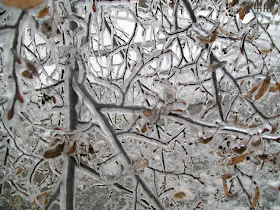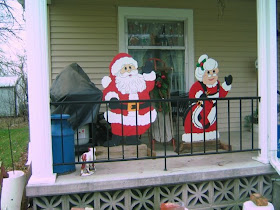On the day of our ice
storm, Dec 19, and for a few days after I took a
lot of
pictures because we do not get conditions like this too often. Naturally, I want to share them. Let us start with the human impact.
I found a couple of sheds that got hit by falling branches. This one was on Vine.

And this on was on Jackson.

Do you think bad road conditions might have had something to do with this damaged fence at Staddon Field?

All the broken branches kept the tree removal guys busy, even if it was mostly removing parts of trees. Here they are working at two houses on Abagail Street.


Enough of people. Here is the court house from as seen from the post office.

Here is the College Street bridge decorated for the holidays.

Below is the hawthorn tree that is next to the post office on a bright sunny morning.

Here are bushes by Dr. Bausman's office on Front Street, also on a bright, sunny morning.

I do not know what kind of berries these are, and I do not remember where I took the picture.

Here are more
pine needles.

This is a weeping willow on the north end of Abagail.

I can tell from the seeds that this was a basswood. It was somewhere in the south part of town near Fleming.

Here is some kind of locust tree the northeast side of town.

This is not another locust, but a redbud. The redbuds are easy to recognize in the winter if they still have their seed pods.

Are you tired of ice yet? Or do you want more? I took a lot of pictures.
 The eastern hemlock has very small cones that are quite similar to those of the tamarck. It has limited commercial use for lumber, but its bark was once used as a source of tannin.
The eastern hemlock has very small cones that are quite similar to those of the tamarck. It has limited commercial use for lumber, but its bark was once used as a source of tannin. A Yale University site says, "It is a poor Christmas tree because the leaves fall upon dying."
A Yale University site says, "It is a poor Christmas tree because the leaves fall upon dying." I have found several hemlock on the south side of Milroy Avenue. Do you know where any others are in Rensselaer?
I have found several hemlock on the south side of Milroy Avenue. Do you know where any others are in Rensselaer?





















































